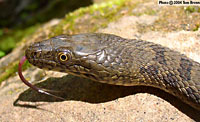Online Field Guide to The Reptiles and Amphibians of Arizona



Greenlee County, AZ
 Coconino Co., AZ |
||
 Coconino Co., AZ |
| NARROW-HEADED GARTERSNAKE Thamnophis rufipunctatus |
Non-Venomous
|
| DESCRIPTION: A medium-sized (up to 1,115 mm or 44″ in total length) gray, greenish tan, tan, or brown snake with paired dark gray, brown, or orange spots running the length of the back. The spots become small and muted posteriorly and eventually fade into the background color as they near the tail. Additional spots mark the sides of the body. The underside is pale cream grading to light gray posteriorly. There are often two parallel rows of dark blotches running the length of the belly. The long and narrow snout gives this snake its common name. The eyes are positioned high on the head and the pupils are round. The dorsal scales are keeled.
DISTRIBUTION: This snake is found along and below central Arizona’s Mogollon Rim at elevations ranging from ca. 2,200′ to 8,000′. Many Arizona populations are in decline and some populations may already be extirpated. Possible threats include introduced crayfish, introduced predatory fish, streamside cattle grazing, heavy recreational use of streams, and water diversions. HABITAT: It is usually encountered in or near clear, rocky streams or rivers in communities ranging from Arizona Upland Sonoran Desertscrub through Petran Montane Conifer Forest. DIET: The Narrow-headed Gartersnake eats fish including dace, chubs, and both native and introduced trout. It may occasionally prey on salamanders. It has also been observed eating Smallmouth Bass on one occasion. REMARKS: Protected in Arizona. It is against Arizona State law to harass, harm, pursue, hunt, shoot, wound, kill, trap, capture, or collect this animal or to attempt to engage in any such conduct. By Thomas C. Brennan Bartlett. 2000. Snakes of North America: WesternRegion. Gulf Publishing Co. Houston, TX Brennan, T. C., and A. T. Holycross. 2006. A Field Guide to Amphibians and Reptiles in Arizona. Arizona Game and Fish Department. Phoenix, AZ Degenhardt, W. G., Painter, C. W., and Price, A. H.. 1996. Amphibians and Reptiles of New Mexico. University of New Mexico Press. Albuquerque. Fowlie. 1965. The Snakes of Arizona. Azul Quinta Press, Fallbrook, CaliforniaStebbins. 1985. Western Reptiles and Amphibians. Houghton Mifflin. New York, NY |
|
Visit Partners in Amphibian and Reptile Conservation:


HOME
Copyright © 2023, Arizona Game and Fish Department. All rights reserved.
If you make use of the textual contents of this site in reports, publications, etc. please cite and credit the author(s) and photographer(s). All photos on this website are copyrighted. However, those found in the species account section may be used for any noncommercial scientific, educational, or conservation purposes provided that photographs are not altered and continue to bear the copyright symbol and name of the photographer. Please contact the photographer regarding commercial use of copyrighted photographs.














